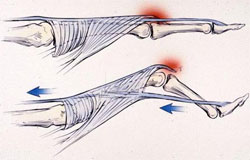Boutonniere Links

A boutonniere finger is a complex imbalance between the tendons of the finger. As you can see from the photo at right (thanks to Dr. Stefano Tognon, of Abano Terme, Italy), the middle finger joint is bent too much and the joint near the nail is not bending at all.
In medical terms, a boutonniere deformity is a complex imbalance between flexor and extensor mechanisms of the finger, with the middle joint of the finger (proximal interphalangeal joint, or PIP) is flexed too much (PIP hyperflexion) and the distal joint (distal interphalangeal joint) is slightly extended beyond neutral (DIP hyperextension). (For the names of the bone and joints of the hand, click here.)
The diagram below helps to explain the imbalance between the tendons. The tendon that goes to the middle bone of the finger (middle phalanx) breaks (shown by the red). When this happens, all of the tendon force goes to the remaining tendon, so the end joint extends too much. In addition, the tendon drops down to below the middle joint, which makes it flex too much. The result is a zig-zag finger.

Here is another illustration of the tendon proble.
These can usually be treated with hand therapy, but it is very important that the therapist knows about hand anatomy. That is why I always use a Certified Hand Therapist. See this page for more information about a Certified Hand Therapist. It is also important that we start treatment right away, so if you suspect you might have a boutonniere finger, please call for an appointment.
For an excellent description, see the website of Dr. Charles Eaton, a superb orthopedic hand surgeon in Florida, and a friend: Extensor mechanism.
Another excellent description can be found on the eMedicine website.
